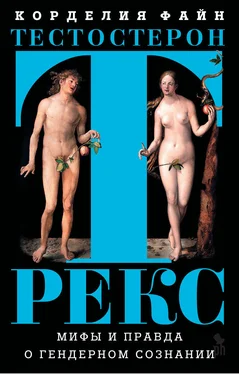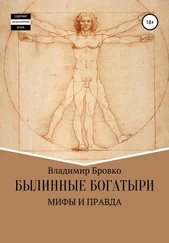31 Shutts, K., Banaji, M. R., & Spelke, E. S. (2010). Social categories guide young children’s preferences for novel objects // Developmental Science, 13 (4), 599–610.
32 Hines, M., Pasterski, V., Spencer, D., Neufeld, S., Patalay, P., Hindmarsh, P. C., et al. (2016). Prenatal androgen exposure alters girls’ responses to information indicating gender-appropriate behaviour // Philosophical Transactions of the Royal Society B, 371 (1668). doi: http://dx.doi.org/10.1098/rstb.2015.0125
33 Напр., Masters, J., Ford, M., Arend, R., Grotevant, H., & Clark, L (1979). Modeling and labeling as integrated determinants of children’s sextyped imitative behavior. Child Development, 50, 364–371; Bradbard, M. R., & Endsley, R. C. (1983). The effects of sex-typed labeling on preschool children’s information seeking and retention // Sex Roles, 9 (2), 247–260.
34 Pasterski, V., Zucker, K. J., Hindmarsh, P. C., Hughes, I. A., Acerini, C., Spencer, D., et al. (2015). Increased cross-gender identification independent of gender role behavior in girls with congenital adrenal hyperplasia: Results from a standardized assessment of 4– to 11-year-old children // Archives of Sexual Behavior, 44 (5), 1363–1375.
35 Fine, C. (2010). Delusions of gender: How our minds, society, and neurosexism create difference. New York: Norton.
36 Jordan-Young, R. (2010). Brain storm: The flaws in the science of sex differences. Cambridge, MA: Harvard University Press; Jordan-Young, R. (2012). Hormones, context, and “brain gender”: A review of evidence from congenital adrenal hyperplasia // Social Science and Medicine, 74 (11), 1738–1744.
37 Напр., Wolf, T. M. (1973). Effects of live modeled sex-inappropriate play behavior in a naturalistic setting // Developmental Psychology, 9 (1), 120–123.
38 Wong, W., & Hines, M. (2015). Effects of gender colorcoding on toddlers’ gender-typical toy play // Archives of Sexual Behavior, 44 (5), 1233–1242.
39 Wong & Hines (2015), там же. Размер эффекта для половых различий в игре с голубым поездом и розовой куклой во втором возрасте составлял d = 0,68 и d = –0,55 соответственно. Размер эффекта для половых различий в игре с розовым поездом и голубой куклой во втором возрасте составил d = 0,26 и d = –0,21 соответственно. Положительный размер эффекта соответствует большему интересу у мальчиков.
4 °Colyle, E. F., & Liben, L. S. (2016). Affecting girls’ activity and job interests through play: The moderating roles of personal gender salience and game characteristics // Child Development, 87 (2), 414–428.
41 Griffiths, P. E. (2002). What is innateness? // The Monist, 85 (1), 70–85.
42 Последние факты можно прочесть: Gangestad, S. W., Haselton, M. G., & Buss, D. M. (2006). Evolutionary foundations of cultural variation: Evoked culture and mate preferences // Psychological Inquiry, 17 (2), 75–95.
43 Griffiths (2002), там же. Цит. на с. 74.
44 Dupre, J. (2001). Human nature and the limits of science. Oxford, UK: Oxford University Press. Все цитаты со с. 31.
45 Gottlieb, G. (2007). Probabilistic epigenesis. Developmental Science, 10 (1), 1–11. Упоминается работа: Hood, K. (2005). Development as a dependent variable: Robert B. Cairns on the psychobiology of aggression. In D. M. Stoff & E. J. Susman (Eds.), Developmental psychobiology of aggression (pp. 225–251). New York: Cambridge University Press. Возраст и опыт выступали в качестве модераторов этих эффектов.
46 Rosenblatt, J. S. (1967). Nonhormonal basis of maternal behavior in the rat // Science, 156, 1512–1514.
47 Haslam, N. (2011). Genetic essentialism, neuroessentialism, and stigma: Comment on Dar-Nimrod & Heine (2011) // Psychological Bulletin, 137 (5), 819–824. Цит. на с. 819.
48 Brescoll, V., & LaFrance, M. (2004). The correlates and consequences of newspaper reports of research on sex differences // Psychological Science, 15 (8), 515–520; Coleman, J., & Hong, Y.-Y. (2008). Beyond nature and nurture: The influence of lay gender theories on self-stereotyping // Self and Identity, 7 (1), 34–53; Martin, C. L., & Parker, S. (1995). Folk theories about sex and race differences // Personality and Social Psychology Bulletin, 21 (1), 45–57.
49 Skewes, L., Fine, C., & Haslam, N. (2015). When boys will be boys, should women be women (and know their place)? Ev idence from two nations on the relations between gender essentialism, gender bias, and backlash. Неопубликованная работа.
50 Gaunt, R. (2006). Biological essentialism, gender ideologies, and role attitudes: What determines parents’ involvement in child care // Sex Roles, 55 (7–8), 523–533.
51 Tinsley, C. H., Howell, T. M., & Amanatullah, E. T. (2015). Who should bring home the bacon? How deterministic views of gender constrain spousal wage preferences // Organizational Behavior and Human Decision Processes, 126, 37–48.
52 Dar-Nimrod, I., & Heine, S. (2006). Exposure to scientific theories affects women’s math performance. Science, 314 (5798), 435; Thoman, D., White, P., Yamawaki, N., & Koishi, H. (2008). Variations of gender-math stereotype content affect women’s vulnerability to stereotype threat // Sex Roles, 58, 702–712
53 Dar-Nimrod, I., Heine, S. J., Cheung, B. Y., & Schaller, M. (2011). Do scientific theories affect men’s evaluations of sex crimes? // Aggressive Behavior, 37 (5), 440–449.
54 Keller, J. (2005). In genes we trust: The biological component of psychological essentialism and its relationship to mechanisms of motivated social cognition // Journal of Personality and Social Psychology, 88 (4), 686–702; Morton, T., Haslam, S., & Hornsey, M. (2009). Theorizing gender in the face of social change: Is there anything essential about essentialism? // Journal of Personality and Social Psychology, 96 (3), 653–664.
55 Wood, W., & Eagly, A. (2012). Biosocial construction of sex differences and similarities in behavior. In J. Olson & M. Zanna (Eds.), Advances in experimental social psychology (Vol. 46, pp. 55–123). Burlington, MA: Academic Press.
56 England, P. (2010). The gender revolution: Uneven and stalled // Gender and Society, 24 (2), 149–166.
57 Jordan-Young (2010), там же. Цит. на с. 130.
58 Chiang, O. (January 7, 2011). Trojan: US market size for vibrators $ 1 billion, twice the condom market size // Forbes.
[Электронный ресурс] http://www.forbes.com/sites/oliverchiang/2011/01/07/trojan-us-market-size-for-vibrators-1-billon-twice-the-condom-market-size/ (дата обращения 08.01.2015).
59 Jordan-Young (2010), там же. Цит. на с. 113.
60 Meynell, L. (2008). The power and promise of developmental systems theory // Les Ateliers de L’Éthique, 3 (2), 88–103. Цит. на с. 97, курсив мой.
61 McCormack, F. (June 24, 2015) How to prevent violence against women. Featured on Big Ideas. [Электронный ресурс] http://www.abc.net.au/radionational/programs/bigideas/fiona-mccormack-preventing-violence-against-women-inaustralia/ 6552078 (дата обращения 27.06.2015). См. также: Flood, M., & Pease, B. (2009). Factors influencing attitudes to violence against women // Trauma, Violence, and Abuse, 10 (2), 125–142.
62 Irleand, J. (November 25, 2015). Greens get Senate inquiry to look into the link between Barbies, toys and domestic violence // Sydney Morning Herald. [Электронный ресурс] http://www.smh.com.au/federal-politics/political-news/greens-link-barbies-trucks-and-childhood-toys-to-domestic-violence-in-call-for-gender-inquiry-20151124-gl716h.html (дата обращения 26.11.2015).
Читать дальше
Конец ознакомительного отрывка
Купить книгу












